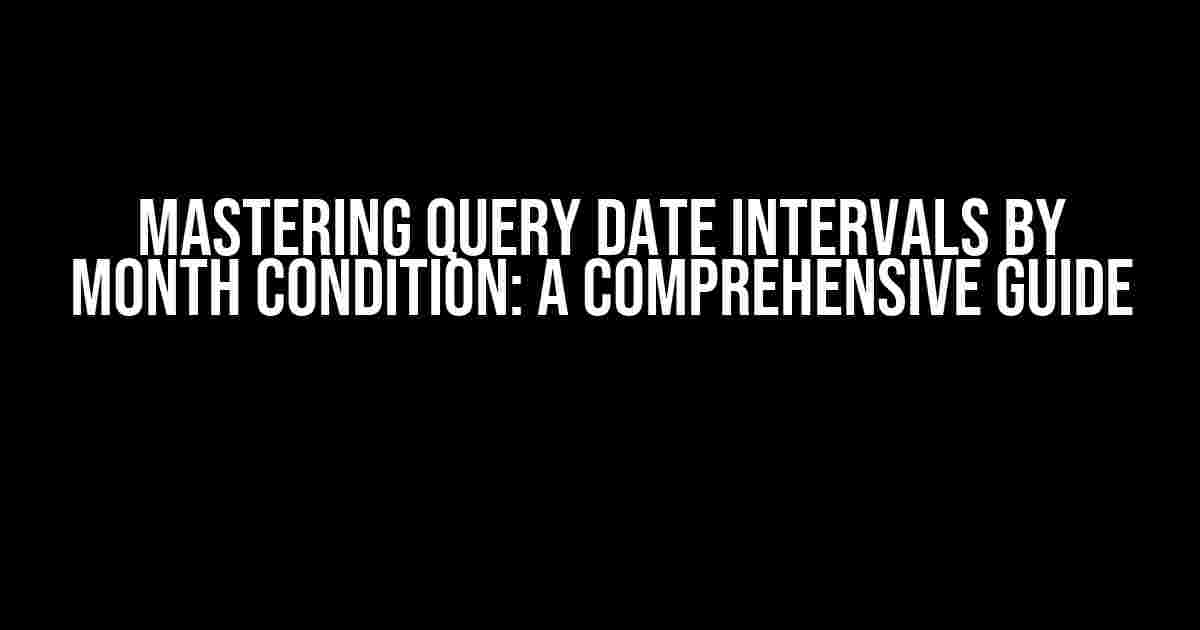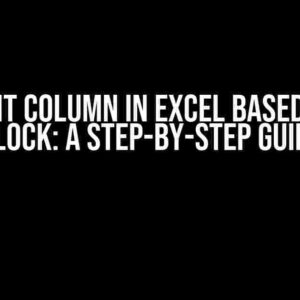Are you tired of manually filtering through seemingly endless rows of data to extract insights based on specific date intervals by month? Do you wish there was a way to simplify the process and save precious time? Well, you’re in luck! In this article, we’ll take you on a journey to master the art of querying date intervals by month condition, transforming you into a data analysis ninja.
- Why Query Date Intervals by Month Condition?
- Understanding Date Intervals and Month Conditions
- The SQL Syntax for Querying Date Intervals by Month Condition
- Advanced Techniques for Querying Date Intervals by Month Condition
- Common Challenges and Solutions
- Best Practices for Querying Date Intervals by Month Condition
- Conclusion
Why Query Date Intervals by Month Condition?
Querying date intervals by month condition is an essential skill for anyone working with data, regardless of their profession or industry. By filtering data based on specific month ranges, you can:
- Identify trends and patterns that would be impossible to spot with raw, unfiltered data
- Make data-driven decisions with confidence, backed by precise insights
- Reduce the noise and clutter in your datasets, allowing you to focus on what matters most
- Automate reporting and visualization tasks, freeing up time for more strategic activities
Understanding Date Intervals and Month Conditions
Before we dive into the nitty-gritty of querying date intervals, it’s essential to understand the concepts of date intervals and month conditions.
Date Intervals
A date interval refers to a range of dates defined by a specific start and end date. This can be a single day, a week, a month, a quarter, or even a year. Date intervals are used to segment data into manageable chunks, allowing you to analyze and visualize patterns and trends.
Month Conditions
A month condition is a specific requirement or filter applied to a date interval to isolate data within a particular month or range of months. For example, you might want to filter data for the month of January, the second quarter of the year, or the summer months (June to August).
The SQL Syntax for Querying Date Intervals by Month Condition
Now that we’ve covered the basics, let’s dive into the SQL syntax for querying date intervals by month condition.
Basic Syntax
SELECT *
FROM table_name
WHERE date_column_name BETWEEN 'start_date' AND 'end_date'
AND MONTH(date_column_name) = desired_month;
This basic syntax uses the BETWEEN operator to define the date interval and the MONTH function to apply the month condition.
Example 1: Filtering Data for a Specific Month
SELECT *
FROM sales_data
WHERE date_column BETWEEN '2022-01-01' AND '2022-01-31'
AND MONTH(date_column) = 1;
This example filters data for the month of January 2022.
Example 2: Filtering Data for a Range of Months
SELECT *
FROM sales_data
WHERE date_column BETWEEN '2022-06-01' AND '2022-08-31'
AND MONTH(date_column) IN (6, 7, 8);
This example filters data for the summer months (June to August) of 2022.
Example 3: Filtering Data for a Quarterly Basis
SELECT *
FROM sales_data
WHERE date_column BETWEEN '2022-04-01' AND '2022-06-30'
AND QUARTER(date_column) = 2;
This example filters data for the second quarter of 2022 (April to June).
Advanced Techniques for Querying Date Intervals by Month Condition
Now that we’ve covered the basics, let’s explore some advanced techniques for querying date intervals by month condition.
Using Date Functions to Simplify Queries
Date functions like DATE_TRUNC, DATE_FORMAT, and EXTRACT can help simplify your queries and make them more readable.
SELECT *
FROM sales_data
WHERE DATE_TRUNC('month', date_column) = '2022-01-01'
AND MONTH(date_column) = 1;
This example uses the DATE_TRUNC function to truncate the date column to the month level, making it easier to filter for the desired month.
Using Subqueries to Filter Data
Subqueries can be used to filter data based on complex conditions or calculations.
SELECT *
FROM sales_data
WHERE date_column IN (
SELECT date_column
FROM sales_data
WHERE MONTH(date_column) = 1
AND YEAR(date_column) = 2022
);
This example uses a subquery to filter data for the month of January 2022.
Common Challenges and Solutions
When working with query date intervals by month condition, you may encounter some common challenges. Here are some solutions to help you overcome them:
| Challenge | Solution |
|---|---|
| Incorrect date formatting | Use the correct date format (YYYY-MM-DD) and ensure consistency throughout your dataset |
| Month conditions not filtering correctly | Verify that the month condition is applied correctly and that the date interval is correctly defined |
| Performance issues with large datasets | Optimize your query by using indexes, reducing the number of columns selected, and applying filters in the correct order |
Best Practices for Querying Date Intervals by Month Condition
To get the most out of querying date intervals by month condition, follow these best practices:
- Use consistent date formatting throughout your dataset
- Verify the accuracy of your data and month conditions
- Optimize your queries for performance and efficiency
- Use clear and concise syntax to avoid errors
- Test and validate your queries with sample data before applying them to large datasets
Conclusion
Mastering the art of querying date intervals by month condition is a powerful skill that can elevate your data analysis game. By following the examples, techniques, and best practices outlined in this article, you’ll be well on your way to extracting insights from your data like a pro. Remember to stay creative, experiment with different approaches, and always keep your data tidy and organized. Happy querying!
Here are the 5 Questions and Answers about “Query date intervals by month condition” in HTML format:
Frequently Asked Question
Get ready to unravel the mysteries of querying date intervals by month condition!
How do I query data for a specific month in a date interval?
To query data for a specific month in a date interval, you can use the `MONTH` function in your SQL query. For example, `SELECT * FROM table WHERE MONTH(date_column) = 12` would return all records from December. You can also use `DATE_FORMAT` function to achieve the same result, like this: `SELECT * FROM table WHERE DATE_FORMAT(date_column, ‘%m’) = ’12’`.
Can I query data for a range of months in a date interval?
Yes, you can query data for a range of months in a date interval using the `BETWEEN` operator. For example, `SELECT * FROM table WHERE MONTH(date_column) BETWEEN 6 AND 8` would return all records from June to August. Alternatively, you can use a combination of `GREATER THAN` and `LESS THAN` operators, like this: `SELECT * FROM table WHERE MONTH(date_column) >= 6 AND MONTH(date_column) <= 8`.
How do I exclude specific months from a date interval query?
To exclude specific months from a date interval query, you can use the `NOT IN` or `NOT EXISTS` operator. For example, `SELECT * FROM table WHERE MONTH(date_column) NOT IN (1, 2, 12)` would return all records except for those in January, February, and December. Alternatively, you can use a combination of `NOT` and `IN` operators, like this: `SELECT * FROM table WHERE NOT MONTH(date_column) IN (1, 2, 12)`.
Can I query data for a specific quarter of the year?
Yes, you can query data for a specific quarter of the year by using a combination of `MONTH` and `CEIL` functions. For example, `SELECT * FROM table WHERE CEIL(MONTH(date_column) / 3) = 2` would return all records from April to June, which corresponds to the second quarter of the year.
How do I query data for a specific year and month?
To query data for a specific year and month, you can use a combination of `YEAR` and `MONTH` functions. For example, `SELECT * FROM table WHERE YEAR(date_column) = 2022 AND MONTH(date_column) = 6` would return all records from June 2022. You can also use a single condition with the `DATE` function, like this: `SELECT * FROM table WHERE DATE(date_column) = ‘2022-06-01’`.
I hope this helps!



